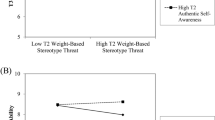Abstract
This study was designed to examine stereotypical beliefs about the physical appearance of employees and the effects of these beliefs on decision-making. Current stereotypes about obese and very thin people were assessed, and the effect of beliefs about obese and very thin people on subjects' evaluations of employee performance was measured. The findings indicated that subjects used information about employees' weight and body build differently, depending on whether they were responding to questions about discipline, the likelihood of recurrence of behavior, or their desire to work with certain employees. Overall, the results suggest that subjects exclude nondiagnostic aspects of employees (e.g., weight and body build) in some types of work decisions.
Similar content being viewed by others
References
Ainlay, S., G. Becker, and L. Coleman (1986).The Dilemma of Difference, New York: Plenum Press.
Asch, S. E. (1946). Forming impressions of personality.Journal of Abnormal and Social Psychology, 41, 258–290.
Asch, S. E. (1952).Social Psychology. Englewood Cliffs, NJ: Prentice-Hall.
Bellizzi, J. A., Klassen, M. L., & Belonax, J. J. (1989). Stereotypical beliefs about over-weight and smoking and decision-making in assignments to sales territories.Perceptual and Motor Skills, 69, 419–429.
Bodenhausen, G. V., & Wyer, R. S. (1985). Effects of stereotypes on decision making and information-processing strategies.Journal of Personality and Social Psychology, 2, 267–282.
Brewer, W. F., & Nakamura, G. V. (1984). The nature and functions of schema. In R. S. Wyer & T. K. Srull (Eds.)Handbook of Social Cognition (Vol. 1). Hillsdale, NJ: Lawrence Erlbaum Associates.
Clayson, D., & Klassen, M. (1989). Perception of attractiveness by obesity and hair color.Perceptual and Motor Skills, 68, 199–202.
DeJong, W. (1980). The stigma of obesity: The consequences of naive assumptions concerning the causes of physical deviance.Journal of Health and Social Behavior, 21, 75–87.
Dickey-Bryant, L., Lautenschlager, G. J., & Mendoza, J. L. (1986). Facial attractiveness and its relation to occupational success.Journal of Applied Psychology, 71(1), 16–19.
Employment Discrimination Coordinator (1989). Section 26, 204. Note (1987).
Facial Discrimination: Extending Handicap Law to Employment Discrimination on the Basis of Physical Appearance. (1987, June).Harvard Law Review, 100(8), 2035–2052.
Festinger, L. (1957).A theory of cognitive dissonance. Stanford: Standford University Press.
Fiske, S. T., & Taylor, S. E. (1984).Social cognition. Reading, MA: Addison-Wesley.
Galper, R., & Weiss, E. (1976). Attributions of behavioral intention to the obese.European Journal of Social Psychology, 5, 425–440.
Harris, M. B., Harris, R. J., & Bochner, S. (1982). Fat, four-eyed, and female: Stereotypes of obesity, glasses, and gender.Journal of Applied Psychology, 12(6), 503–516.
Hastie, R., Ostrom, T. M., Ebbesen, E. B., Wyer, R. S. Jr., Hamilton, D. L., & Carlston, D. E. (Eds.). (1981).Person memory: The cognitive basis of social perception. Hillsdale, NJ: Lawrence Erlbaum Associates.
Heider, F. (1958).The psychology of interpersonal relations. New York: Wiley.
Jasper, C. R., & Klassen, M. L. (1990a). Perceptions of salesperson's appearance and evaluation of job performance.Perceptual and Motor Skills, 71, 563–566.
Jasper, C. R., & Klassen, M. L. (1990b). Stereotypical beliefs about appearance: Implications for retailing and consumer issues.Perceptual and Motor Skills, 71, 519–528.
Jones, E. E., & Davis, K. E. (1965). From acts to dispositions: The attribution process in person perception. In Berkowitz, L. (Ed.).Advances in experimental social psychology (Vol. 2, 219–266). New York: Academic Press.
Katz, I. (1981).Stigma: A Social Psychological Analysis, New Jersey: Lawrence Erlbaum Associates.
Kennedy, D., & Homant, R. (1984). Personnel managers and the stigmatized employee.Journal of Employment Counseling, 21, 89–94.
Klassen, M. (1987). The cognitive basis of social judgment: The role of stereotypical beliefs in the processing of information about obese and thin people. Unpublished doctoral dissertation, Kansas State University.
Larkin, J. C., & Pines, H. A. (1979). No fat persons need apply: Experimental studies of the overweight stereotype and hiring preference.Sociology of Work and Occupations, 6(3), 312–327.
Lerner, R. M. (1969). Some female stereotypes of male body build-behavior relations.Perceptual and Motor Skills, 28, 363–366.
McAdams T., Moussavi, F., & Klassen, M. L. (1990). Employee appearance and the Americans with disabilities act: An emerging issue? Working Paper, University of Northern Iowa, Cedar Falls, IA.
Morrow, P. C. (1990). Physical attractiveness and selection decision making.Journal of management, 16(1), 46–60.
Orbach, S. (1982).Fat is a feminist issue II. New York: Basic Books.
Pauley, L. L. (1989). Customer weight as a variable in salespersons' response time.The Journal of Social Psychology, 129(5), 713–714.
Price, R. A., Cadoret, R. J., Stunkard, A. J., & Troughton, E. (1987). Genetic contributions to human fatness: An adoption study.American Journal of Psychiatry, 144(8), 1003–1008.
Rothblum, E. D., Miller, C. T., & Garbutt, B. (1988). Stereotypes of obese female job applicants.International Journal of Eating Disorders, 7(2), 277–283.
Ryckman, R. M., Robbins, M. A., Kaczor, L. M., & Gold, J. A. (1989). Male and female raters' stereotyping of male and female physiques.Personality and Social Psychology Bulletin, 15(2), 244–251.
Staffieri, J. R. (1967). A study of social stereotype of body image in children.Journal of Personality and Social Psychology, 7, 101–104.
Stunkard, A. J., Harris, J. R., Pederson, N. L., & McClearn, G. E. (1990). The body-mass index of twins who have been reared apart.The New England Journal of Medicine, 322(21), 1483–1487.
Sujan, M., Bettman, J., & Sujan, H. (1986). Effects of consumer expectations of information processing in selling encounters.Journal of Marketing Research, 23, 346–353.
Weiss, E. (1980). Perceived self-infliction and evaluation of obese and handicapped persons.Perceptual and Motor Skills, 50, 1268.
Wyer, R. S., & Srull, T. K. (1990). Human cognition in its social context.Psychological Review, 93(3), 322–359.
Young, L. M., & Powell, B. (1985). The effects of obesity on the clinical judgments of mental health professionals.Journal of Health and Social Behavior, 26, 233–246.
Author information
Authors and Affiliations
Rights and permissions
About this article
Cite this article
Klassen, M.L., Jasper, C.R. & Harris, R.J. The role of physical appearance in managerial decisions. J Bus Psychol 8, 181–198 (1993). https://doi.org/10.1007/BF02230384
Issue Date:
DOI: https://doi.org/10.1007/BF02230384




